Abstract
1Million Women is an Australian charity whose current number of members is about 165, 220. This promotional strategy project covers 1Million Women. Inspiration for the project arises from of 1Million Women being and organization and a movement that is already causing change in climate change matters, an area that many people do not know and would like to find out how they can contribute to the change.
The problem of 1Million Women is that its target population needs to have an updated story whenever they are interacting with any media channel of the 1Million Women. This should also make the organisation vibrant. The membership target for the campaign is 190, 220 to 195, 220 members in 6 months. The other target is to increase donors by relying on public relations, social media, and advertising while other channels playing secondary roles in the integrated marketing communications strategy.
Introduction
1Million Women is an Australian charity that boasts a growing membership that currently numbers 165,220 (1Million Women, 2015). The organisation terms itself as a movement for women and girls. Its activities revolve around the global fight against climate change. In its capacity, 1Million Women takes practical actions in the everyday lives of people as its preferred way of combating climate change. Natalie Isaacs is the founder of the organization. She attributes the organization’s impact to the collective action of women and girls, irrespective of their position to take measures that reduce the overall footprint of their lives on the planet (1Million Women, 2015).

This project focuses on the 1Million Women because the organisation provides room for all kinds of women to work with individuals and groups to create solutions that will influence other women and everyone in society, especially in Australia. Women and girls are free to join and contribute to the organization in any way that they like. There is no discrimination based on age or ability. As long as a woman desires to take part in combating climate change, the organisation is there to provide her with the appropriate channel for doing so in a constructive and socially sustainable way (1Million Women, 2015).
Social Media Strategies
This integrated marketing communication projects adapts its strategy to the concept of purple cows. The concept refers to the idea of having a very striking realisation about a piece of information or action, which is not normal but it is very interesting and worthy of speaking about.
In marketing, it refers to the strategies that an organisation or individual will use to make their value proposition and their brand literally stands out the way a purple cow would in an ordinary society (Bailey, 2011). This project is going to apply the same strategy to come up with an integrated marketing communications plan for 1Million Women that increases the organisation’s overall membership and donors to increase its impact to the society significantly.
Media reviews show that people are used to traditional forms of integrated marketing channels and that they are likely to dismiss yet another marketing message coming as noise. Therefore, the important thing that this promotional strategy plan will be doing is being persistent, until it cannot be ignored. At the same time, the campaign will be interesting on social media (Belch, Belch, Kerr, & Powell, 2014). Moreover, it will be very simple to opt it such that the target audience will find it hard to ignore it. With this strategy, this project hopes to achieve an objective of increasing the membership of 1Million Women significantly.
Rationale for the project
This project’s interest in the 1Million Women comes from the idea of a movement that is making a change in an area that many people are not yet aware of how they can contribute to change (1Million Women, 2015). Unlike typical charities that give food and shelter or money to the poor, the work of this organisation is to prevent catastrophic consequences of climate change and to benefit everyone in society.
At the same time, it provides a channel for empowering every woman in society. It uses a subtle and very powerful approach to address gender empowerment and it makes women the stewards of a healthier, safer and accommodating climate with a good environment, which is home for everyone. The biggest hindrance for the organisation is its limited membership, which curtails its potential influence in society. Therefore, membership growth will make it more relevant and increase its opportunities for getting sufficient funding to coordinate efforts in stopping climate change.
Profile of the campaign audience
The campaign audiences will be women and girls. The age range will be from 15 to 55 years, which represents the most active group to consider joining the organisation (1Million Women, 2015). Girls who are younger than 15 years will need the supervision of their guides when they are signing up to become members of the organisation. They may not be aware of their personal details relevant for their identification. On the other hand, women older than 55 are still capable of joining the organisation; however, their preferences and appeal may differ from that of women younger than that age.
Therefore, the target age will remain 15 to 55 years old for the campaign message to stay congruent. The campaign audience has access to the Internet, newspapers and has at least 30 minutes in a day that can be used to interact with social media. It is sufficiently educated to make sense of climate change and the basis for making the world a better place. The audience is also empathetic to the plight of people negatively affected by increased mindless consumerism in a globalised world.
Audience perception/problem
Currently, the organisation is making progress towards its goals. However, there is a mismatch of its overall campaign process. Different strategies exist as isolated tools of communication. For example, there is no deep integration of what happens on the official website with the Twitter, Facebook, and YouTube channels. The audiences need to have an updated story whenever they are interacting with any media channel of 1Million Women. This way, they will be able to transition smoothly from one media to another (Boundless, 2014).
They will also be able to trace their progress and build the required incentive to sign up as members and proceed to make relevant word-of-mouth sharing contribution about the charity organisation. Without sufficient integration, many of the target audience and current members end up losing interest, as they do not see the continuation of their engagement after joining. The audience likely develops a misguided thought that sees the organisation as a static one, with no real appeal for everyday engagement as it claims. The role of the campaign and future strategies is to correct this misconception.
Campaign objective
The first campaign objective is to increase the membership of 1Million Women by at least 25,000 to 30,000 members who will have signed up on the official organisation’s website. The second campaign objective is to increase the number of donors to 1Million Women. The current membership number is visible on the main site. The new target will be 190, 220 to 195, 220 members.
A woman’s gender identity is constructed outside herself. It is something that she learns to accept and love as she grows. Beyond the gender identity, women are individuals who have additional identities developed with opportunities that face them as individuals or communities (Gilchrist, Bowles, & Wetherell, 2010). For example, there is the Australian woman’s identity, and any other association that a woman has will become part of the characteristic of her identity.
The objective of the 1Million Women IMC campaign is to provide an additional identity for the women of Australia, and use that new identity to champion for actions that tackle the social, environmental and the economic problem of climate change. The existence of multiple identities implies that everyone can be involved in different ways in groups and collective activities. Therefore, there is no limit to the ways that women can contribute to the collective action of 1Million Women.
This campaign aims to realise the additional ways that are not yet in use. It shall do that by first increasing the number of participants in the organisation and renewing the commitment of already registered members to enhance the vibrancy of the organisation. The campaign is going to rely on the commonality aspect of being a woman, belonging to a country, and being concerned about the welfare of the current society and future generations. The donations to the organization should also increase once the members increase and the commitment of the existing members also improves.
Campaign theme or “Big Idea”
The big idea is that signing up for 1Million Women is the best thing, which women can do to support the movement. It is easy and fast. It should take very little effort. It will be satisfactory to do any little thing that reduces the problem of climate change after joining. Few things can include using renewable sources of energy, spreading the news about sustainable practices for home and work, and sharing content on Facebook and Twitter about 1Million Women.
Members and would-be members are free to say anything about the various ways they can help the movement. They are also free to share content about the organisation or their stories with the organisation. Highlighting members’ stories will be the main agenda, as it will help in bringing out the big idea that joining other people with a similar agenda of making the world sustainable is the best way to give back to society (Cramer, 2014).
Therefore, the campaign will use logical and emotional appeals to be meaningful to the ordinary lives of the target audience. The overall message will be “Join the Movement, Become 1Million Women & Girls Fighting Climate Change.”
Marketing communications strategy and tools
The strategy is to come up with a product for the 1Million Women that will be unique and attractive to its target audience. The second step of the approach is to develop the basis for the integrated communication. The expectation here is that the strategy will find the main motivators that are willing to go out of their way to ensure that the marketing message transmits to all the social networks, both offline and online, to reach the highest number of people in the shortest time possible.
The third step, which also works as a motivation for the strategy, is to come up with a remarkable idea that is being promoted together with the underlying reasons for the campaign. This will ensure that it will be very compelling and easy for people who interact with the campaign message to opt in and become brand ambassadors for 1Million Women (Colbert, 2009).
Primary tools
Internet – 40% of the budget
The Internet strategy is going to use a collection of social media tools and content marketing approaches. The tools identified for the campaign are Facebook, Twitter, Blogs, Instagram, Chat applications, Vimeo, and YouTube. Content marketing will involve press releases, articles, and editorial pieces published on strategic websites on the Internet, with a significant outreach to the target population (Bailey, 2011).
There will be a feedback loop along all the messages pushed through the campaign. The campaign will encourage people who have interacted with the organisation to share their experience. The campaign will capture this feedback in various social channels like YouTube, Facebook, Twitter, and other social network sites. The critical feedback collected will revolve around the identity of 1Milloin Women, the perception that people have about it, how the organisation works, and what is in it for anyone willing to participate.
Linking the responses on the various Internet channels will be a way of stimulating the conversation further. Consequently, more people will get to know about the involvement of other people. The campaign wants to create a group mentality. Those who are within the group want to keep discussing features of the group while those who are outside the group keep on interacting with the media and conversation content of the group that they find it irresistible not to join or at least seek to find out more about the group.
Workers employed in the campaign will continue following up with any interest that people express. The Internet campaign will be responsive to the feedback and the reports that various channels provide. There will be a persistent monitoring of conversation on the popular social sites encouraging people to keep engaging with the 1Million Women brand.
Twitter will be the first launch pad for giving people ideas about 1Million Women. On Twitter, the goal is to come up with sufficient comments and information updates that match the existing positive trends of the day. This way, there will be a high chance of people who are in touch with the trending topics on Twitter will be able to find out about 1Million Women.
Once traction builds on Twitter, there will be the use of tweets to create meaningful content on the Facebook page of the organisation. At the same time, there will be posts on Facebook regarding any interesting thing about the campaign covered in offline media and on the Internet prior and during the campaign.
Once women take up any action in relation to the activities of 1Million Women, the campaign will be asking them to share whatever they did with others through tweets, Facebook posts, Pinterest mentions and online videos. They will be free to post on the organisation’s Facebook page, leave a comment on the campaign blog, put a picture on Instagram, and retweet or reply to the 1Million Women Twitter handle. The idea here is to transform a personal conversation between two or more people and the 1Million Women brand into a public relations matter for the organisation that will act as social proof for other target women to feel the need to be part of something great in their society (Cova, Pace, & Park, 2007).
Website analytics will also help to show the number of visitors to the website during the campaign period. Many social media tools like Facebook and Twitter will provide engagement analytic tools that help to show the popularity of a message or an update. Thus, throughout the campaign, it will be possible to see exactly how many people are being reached (Vasquez & Escamilla, 2014). The following are illustrations of the potential uses of Facebook as a social media channel and messages that will help drive up recruitment.
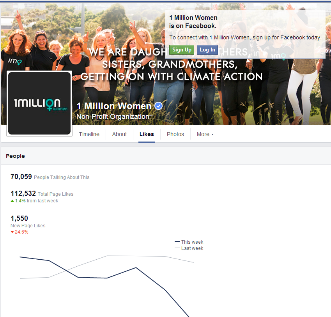
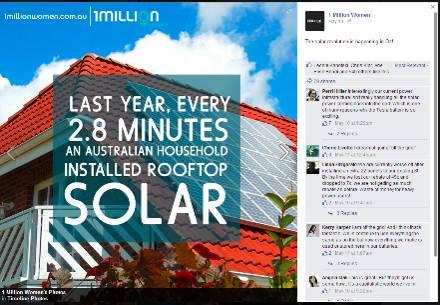
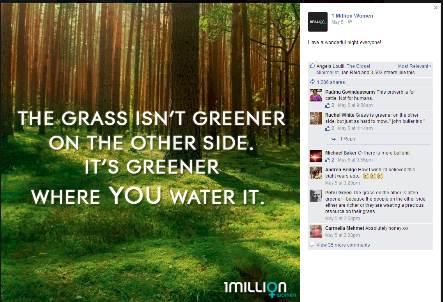
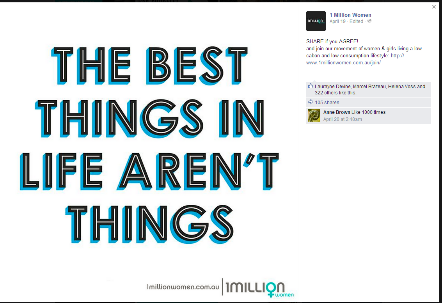
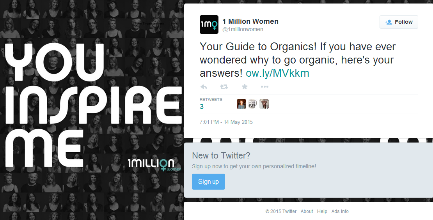
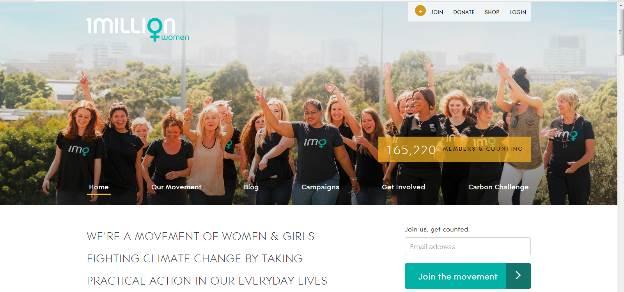
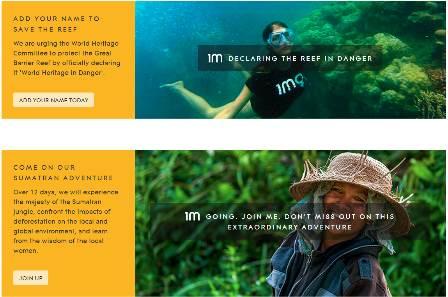
Advertising – 30% of the budget
The main form of advertising will be newspapers of all kinds, including tabloids because of high readership. Meanwhile, Internet advertising will be used less because social media marketing will be taking place. The ratio of print to internet advertising will be 7 to 3 respectively. Advertising will rely on posters, newspapers and other print channels as the main avenues for reaching out to the target audience. In addition, the copy message of advertising will be a simple fact with an emotional appeal.
Ads will then have a tag line urging people to learn more about 1Million Women and join 1Million Women. They will include the 1Million Women logo and a compelling background image of a person. The image used will reflect the message that the particular ad runs. The creative team will come up with different ideas and test them in the weeks of the campaign. The messages that appear to correspond well with the target audience will be amplified in subsequent ad campaign phases in the respective media (Wang, Hernandez, Minor, & Wei, 2012). The print ad will also match the online advertising.
Online advertising, which will be used less than the print ads, will incorporate smart options that the internet medium provides. For example, users will be able to click on ads and go directly to the sign-up page on the organisation’s website. They may also be directed to social network pages where they can contribute their stories or share other stories that are carried in the pages (Belch et al., 2014). The main message will be to have the target audience act in any way that they see will contribute to the growth of 1Million Women’s membership and impact in society. With Internet advertising, the campaign will be able to show how many people are responding to ads on average and the actions they are taking after responding to the ads (Birkner, 2015).
Public relations – 15% of the budget
Another cornerstone of the campaign will be public relations, where the message will linger on for longer among the target audience and give people adequate time to contemplate and take action. Public relations strategies will shape the conversations about the 1Million Women. The more people talk about the organisation, the higher its relevancy to the community will be.
Therefore, the aim of the campaign will be to use public relations to establish connections that unite women, inspire them to be part of the community that does something about climate change, and help them grow in their individual and group capacities (Caslione, 2003). The goal of the public relations campaign will be to influence the target audience’s opinion.
The 1Million Women organisation will seek to associate itself with other entities that are doing a positive thing about stopping or managing climate change. It will identify with other noble causes associated with its target population. The identification with what women and girls are doing to better their lives in the context of making the earth a sustainable place to live in will generate brand loyalty around the organisation cause of being a positive influence of stopping climate change.
For example, being vocal through new and traditional media or using free opportunities for publicity to drive its carbon challenge agenda for women and girls to take up, are public relations efforts that will allow 1Million Women to position its narrative well and gain brand exposure (Colbert, 2009).
Local media is expected to cover public engagements of 1Million Women campaigns and increase awareness using the prime time news. This will create sufficient momentum for word-of-mouth sharing through various social media platforms. The organisation will use the opportunity to increase its engagement by increasing the integration of different communication channels to ensure that the common message of increasing membership to achieve its goal persists throughout any engagement that it has with its target audience.
Secondary Tools
Sales promotion – 5% of the budget
Sales promotion in the case of 1Million Women will be to increase the number of signups. Therefore, for this campaign, the sales promotion will have strategic placement of the sign up booths in strategic places in most shopping malls and other public gathering events across the country. There will be a push strategy. It will focus on organisations that agree to collaborate with 1Million Women. This will ensure that as many people are exposed to the sign up booths that will be set up on their premises.
The sales push will also rely on sensitisation that will be created through advertisements and online campaigns on social media (Belch et al., 2014). Therefore, many people will have interacted with the message and be acting on reinforcements. This strategy relies on the fact that consumers do not make a snap judgement. Instead, they work slowly as they increase their knowledge about a product or a feature. Here, they will have interacted with various push efforts by the 1Million Women sales promotion team in different public spaces and outlets around the country. If they make up their minds to join 1Million Women, they will have an opportunity to do so at the sign up booths.
Willing organisations may promote the membership recruitment drive by providing branded merchandise such as T-shirts. People will be given the merchandise when they agree to contribute to the campaign by signing up or participating in the creation of other promotion material like videos showing the ways that the 1Million Women organisation can affect the lives of Australians positively.
Direct Marketing – 5% of budget
Direct marketing is another important strategy that will help the IMC campaign succeed in achieving its objective. For 1Million Women, the approach will provide legitimacy and serve as the email and social media engagement foundation. Therefore, the actual Internet strategies that have been described in this plan and their underlying strategies will be an extension of the direct marketing campaign. There will be a need to use letters through direct mails, given that the campaign will target women of all ages and their friends and families (Doole & Lowe, 2012).
Personal Selling – 5% of the budget
Campaign officials appointed by the organisation during the campaign period to increase membership will do personal selling. The membership recruiters will have portable devices and leaflets to hand out to people to inform them about the recruitment services. They will supplement the work of sign up booths, which will be operating on a self-care basis. The recruiters will take details of new members and register them on the 1Million Women website. They will furnish the new members with their login details on the spot. In addition, they will provide members with the bookmarks and help them set up their mobile devices for future engagement.
These devices may include smartphones and tablets. In some cases, they will also demonstrate how people can interact with the organisation through social media and other online or offline channels. In this regard, the campaign will restrict the personal selling approach to face-to-face communication. The importance of personal selling to the campaign will be to give back information about the sign-up process.
Given that they will be in face-to-face communication with members, the recruiters will also provide the right information about the profile of the campaign audience and the best ways of adjusting strategies to respond to any emerging issues. The recruiters will represent the organisation before the new members. They will also represent the new members to the organisation (Balmer & Gray, 2003).
Support Media – 10% of the budget
The purpose of support media will be to create awareness, get attention, and enhance the retention of the campaign so that the target audience gets compelling reasons to sign up as new members of the 1Million Women organisation. Support media will include the use of mobile billboards that are mounted on trucks, vans, and trailers. The organisation will use existing service providers to run its campaign. The choice of mobile trucks will help the organisation reach many people in a short time, given that the targeted audience will be the same as the one being served by the personal selling strategy and the sales promotion.
Media Schedule
The campaign will run for 6 months and it will be scheduled in the following manner.
Campaign Measurement
The metrics for the campaign success will be the achievement of the target recruitment number of 190, 220 to 195,220 members. In addition, the amount of publicity that will have been created, the level of engagement that the target audience will show, and the increase in the number of donations to the organisation will be other parameters measured. To measure publicity, the team will consider the raw numbers presented by different channels, such as social media, by looking for the indications of engagement, which include message sharing, updates mentioning 1Million Women, and media uploaded by users.
The number of visitors to the various social media channels, the number of interactions that recruiters will have during the campaign, and the number of visitors to the official website will also be measures used to evaluate the success of the campaign. Public relations achievements will be measured by the extent of content marketing, press releases, and news coverage that the campaign will gain in online and offline media.
Conclusion
Although there are tens of charities that do major programs in Australia, very few have a cause that can influence the lives of every Australian concurrently. At the same time, knowledge of climate change is prevalent, but efforts to contain the phenomenon are usually left to government policies and companies’ corporate social responsibility efforts.
The proposed campaign is going to give women and girls an excellent opportunity for empowerment to make meaningful change in society without having to fight the male hegemony. It will provide a social basis for supporting a cause, improving one life or other people’s life, and overall serve as a channel for personal leadership in society. The intention of the campaign it to meet its objective of increasing recruitment and exposing more women in the fight against climate change.
References
1Million Women. (2015). Web.
Bailey, M. (2011). Internet marketing: An hour a day. Indianapolis, IN: Wiley Publishing.
Balmer, J. M., & Gray, E. R. (2003). Corporate brands: What are they? What of them? European Journal of Marketing, 37(7/8), 972-997.
Belch, G., Belch, M., Kerr, G., & Powell, I. (2014). Advertising and promotion: An integrated marketing communication perspective (3rd. ed.). Sydney, Australia: McGraw-Hill Australia.
Birkner, C. (2015). Ad messaging efficacy differs based on country’s GDP, study shows. America Marketing Association.
Boundless. (2014). Introduction to integrated marketing communications. Boundless.
Caslione, J. A. (2003). Globalization demands new marketing skills. Marketing News, 37(14), 7-8.
Colbert, F. (2009). Beyond branding: Contemporary marketing challenges for arts organizations. International Journal of Arts Management, 12(1), 14-20.
Cova, B., Pace, S., & Park, D. J. (2007). Global brand communities across borders: The Warhammer case. International Marketing Review, 24(3), 313- 329.
Cramer, T. (2014). Applying the secrets of gamification to your digital marketing strategy. Web.
Doole, I., & Lowe, R. (2012). International marketing strategy. Stamford, UK: Cengage Learning.
Gilchrist, A., Bowles, M., & Wetherell, M. (2010). Identities and social action: Connecting communities for a change. London, UK: Community Development Foundation.
Vasquez, G. A., & Escamilla, E. M. (2014). Best practice in the use of social networks marketing strategy as in SMEs. Procedia – Social and Behavioral Sciences, 148(25), 533-542.
Wang, Y. J., Hernandez, M. D., Minor, M. S., & Wei, J. (2012). Superstitious beliefs in consumer evaluation of brand logos: Implications for corporate branding strategy. European Journal of Marketing, 46(5), 712-732.